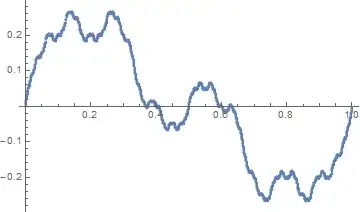Here is a way to find Julian's example. This functional equation is very well behaved under the Fourier transform. Let $f$ be an integrable solution of the equation. For any integer $n$, let:
$$\hat{f} (n) := \int_0^1 f(x) e^{-2\pi inx} \ dx.$$
Then:
$$\hat{f} (n) = \int_0^1 f \left( \frac{x}{2}\right) e^{-2\pi inx} \ dx + \int_0^1 f \left( \frac{x+1}{2}\right) e^{-2\pi inx} \ dx \\
= 2\int_0^{\frac{1}{2}} f (u) e^{-2\pi in (2u)} \ dx + 2 \int_{\frac{1}{2}}^1 f (u) e^{-2\pi in (2u-1)} \ dx \\
= 2 \hat{f} (2n).$$
Necessarily, $\hat{f} (0) = 0$. To get continuous solutions, take any sequence $(a_{2k+1})_{k \in \mathbb{Z}}$ which is summable and defined on the odd integers. Then extend this sequence to the integers by $b_0 = 0$ and:
$$b_{2^n (2k+1)} := 2^{-n} a_{2k+1},$$
and put $f(x) := \sum_{n \in \mathbb{Z}} b_n e^{2 \pi i nx}$. Then $f$ is continuous (its Fourier coefficients are summable), and satisfies the functional equation. If you want real-valued solutions, take the imaginary or real part (or choose $a_{-k} = a_k$).
More generally, the Fourier transform is well-defined when the coefficients are square-integrable. So you can choose a sequence $(a_{2k+1})_{k \in \mathbb{Z}}$ whose square is summable, extend it in the same way to a sequence $(b_n)_{n \in \mathbb{Z}}$, which will still be square-summable, and take the inverse Fourier transform. For instance, with $a_{2k+1} = -i(2k+1)^{-1}$, you get $b_n = -\delta_{0n} i n^{-1}$, so a solution to the functional equation is:
$$f(x) = 2\sum_{n=1}^{+ \infty} \frac{\sin (2 \pi n x)}{n},$$
which, up to a multiplicative constant, is $1-2x$. If you try to make this function periodic, it will have a discontinuity at the integers (which is hidden here by the fact that we worked on $[0,1]$), which explain that the coefficients of the Fourier transform are not summable.
It can be shown that any continuous solution $f$ to the functional equation such that $f(0) = f(1)$ must at best have a modulus of continuity $\omega_f (h) \simeq h |\ln (h)|$ (and I think that this modulus of continuity is optimal almost everywhere), so they cannot be $\mathcal{C}^1$, and they look indeed pathological. This is because their Fourier coefficients do not decay very quickly.
With this method, you can solve other similar functional equations, say, for instance,
$$f(x) = \frac{2}{3} \left[ f \left( \frac{x}{2}\right) + f \left( \frac{x+1}{2}\right) \right],$$
or:
$$f(x) = f \left( \frac{x}{3}\right) + f \left( \frac{x+1}{3}\right) + f \left( \frac{x+2}{3}\right),$$
as well as some similar functional equations with more variables.
